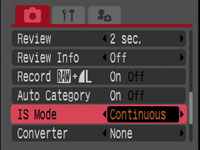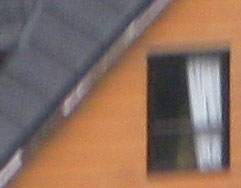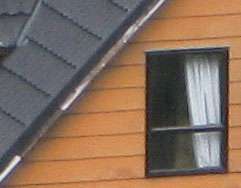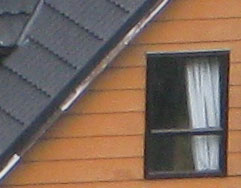Canon PowerShot G9
-
-
Written by Gordon Laing
Canon PowerShot G9 image stabilisation
Canon PowerShot G9 features
Lenses / Screen and menus / Sensor and processing / anti-shake
The earlier PowerShot G7 was actually the first in the G-Series to feature built-in optical image stabilisation. So by sharing the same optical system, the new G9 inherits the facility to deliver what Canon claims to be up to three stops of compensation. In practice this means if the slowest exposure you could safely handhold your camera at a certain focal length was, say, 1/60, then three stops of compensation would allow you to reduce the exposure to 1/8 (or more precisely, 1/7.5).
 |
Like the G7, Canon offers three stabilisation modes: Continuous, Shoot Only and Panning. Continuous is beneficial when it comes to composing, especially at macro or long focal lengths, as it’s on all the time, but the Shoot Only mode can potentially offer greater compensation as the system only has to start from a central position. The G9’s Panning only corrects the vertical axis for when you’re tracking a subject sideways.
To put the G9’s stabilisation to the test we photographed a building with the camera fully zoomed-in to an equivalent of 210mm – according to traditional photographic advice, you’d need a shutter speed of at least 1/210 to eliminate any camera shake. We then set the G9 to Shutter Priority mode and took handheld photos at gradually slower exposures in one stop intervals, starting at 1/250. We repeated this process with the G9’s stabilisation off, set to Continuous, and set to Shoot Only.
Canon PowerShot G9 IS disabled |
Canon PowerShot G9 IS Continuous |
Canon PowerShot G9 IS Shoot Only | ||
 |
 |
 | ||
100% crop, 7.4-44.4mm at 44.4mm, 1/60, 100 ISO |
100% crop, 7.4-44.4mm at 44.4mm, 1/60, 100 ISO |
100% crop, 7.4-44.4mm at 44.4mm, 1/60, 100 ISO |
Above are crops from three examples of the house taken with IS disabled, followed by the two main IS modes, Continuous and Shoot Only. These images were taken with the G9 zoomed-into an equivalent of 210mm and at a shutter speed of 1/60, the slowest we could handhold using stabilisation and still achieve a sharp result. The crops are presented here 1:1, so you’re viewing them all at 100%.
Clearly the shutter speed of 1/60 was insufficient to avoid camera shake without stabilisation, but activating either Continuous or Shoot Only IS modes effectively eliminated it. Dropping to 1/30 though, was too far for the stabilisation to cope with. The slowest shutter speed we could handhold a sharp shot without stabilisation was between 1/125 and 1/250, so in this particular example we only enjoyed one to two stops of compensation.
Interestingly like the G7, in all our tests with IS we couldn’t find an example where the Shoot Only mode delivered superior results to the Continuous mode. Of course this could simply be due to the conditions under which we tested, but from our experience here we’d opt for Continuous mode because it appeared to deliver equally effective results while showing a preferable stabilised live view.
Now let’s see how the camera performs in our G9 Outdoor results.




